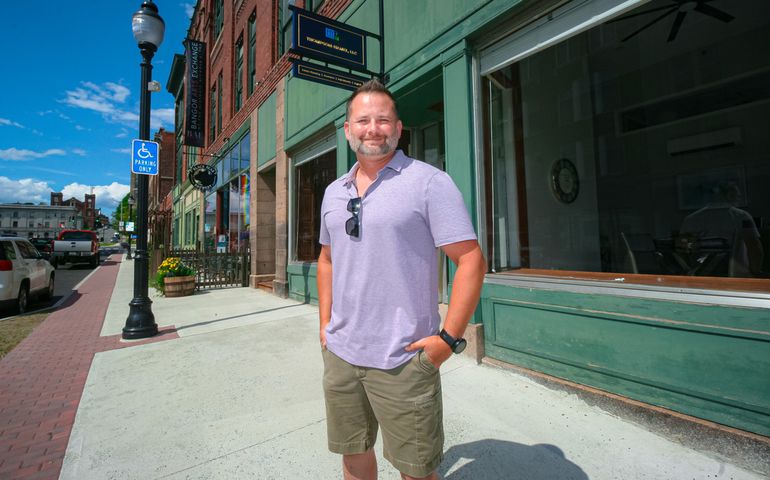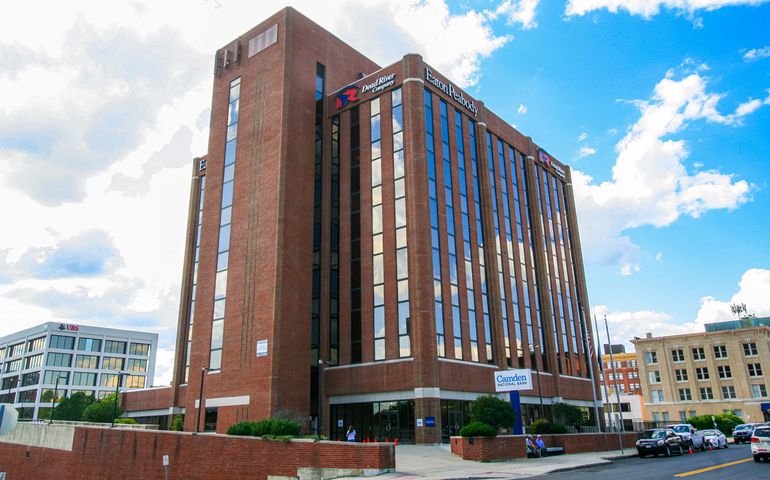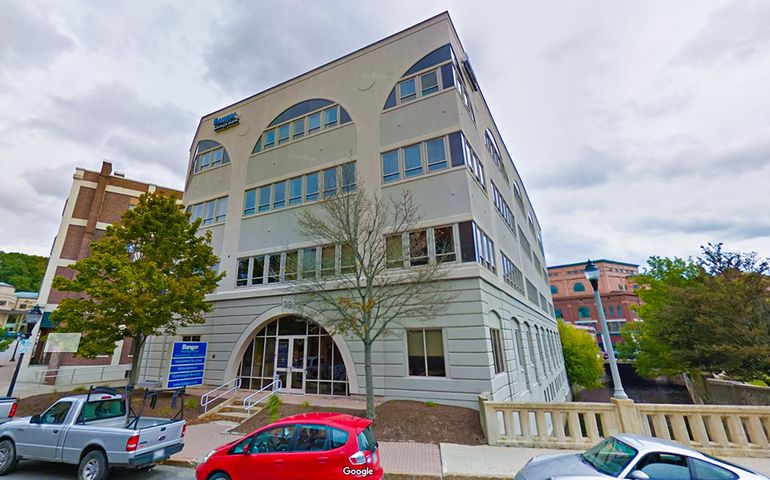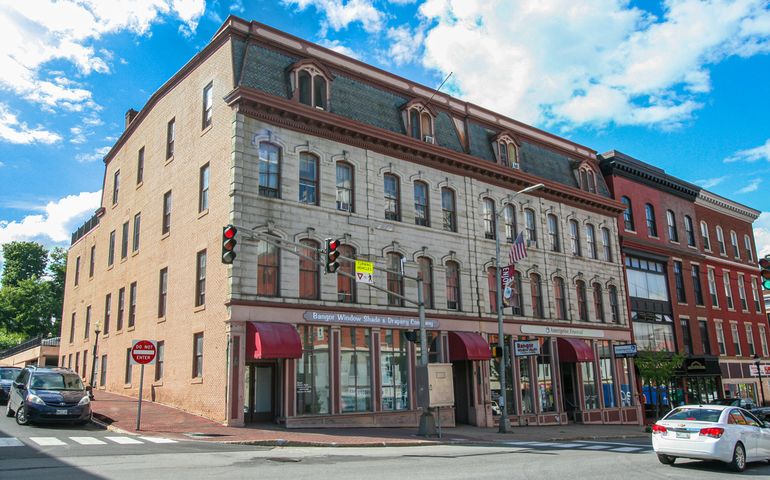Queen City revival: Downtown Bangor’s redevelopment continues on Exchange Street
Just three years ago, an entire block on Exchange Street in Bangor was devoid of activity.
The lights were out, the exteriors of six historic buildings needed work. The interiors were a mix of dated historical styles, bland office space and old infrastructure.
Today, thanks to developer Adam Moskovitz, the block is a lively hub of arts, culture and small businesses. In 2016, Moskovitz acquired the portfolio, which included a 1912 Classical Revival bank at the corner of Exchange and State, and a building called the Nichols Block that was built in 1892 and has a grand ballroom on the third floor that was the original home of the Bangor Symphony Orchestra.
An Army veteran and owner of ANM Properties LLC, a Bangor property management firm, Moskovitz’s primary focus at the time was on buying, renovating and renting historic homes. An entire block of buildings was a big leap driven by the value-add opportunity.
“It was a pretty big risk,” he says.
But he tackled it bit by bit, performing code and safety improvements, updating storefronts and interiors and looking for prospective tenants.
His first prospect was the Bangor Symphony Orchestra. The organization was intrigued by the thought of returning to its roots and being in a larger and more central location. A year of negotiations with the BSO and an arts incubator called Launchpad birthed a new organization called Bangor Arts Exchange. Today, the upper-stories are alive with the arts, including the Bangor Symphony Orchestra, Bangor Youth Symphony Orchestra, Launchpad and Bangor Ballet, which have offices there along with space for performances, rehearsals, classes and other gatherings throughout the year.
At the street level, there’s now Black Bear Brewing Co., a shop called City Drawers, and the financial services company Thompson-Hamel. Some of the upper-story space is occupied by offices and a video production company. In sync, the city installed wide sidewalks, new street paving, attractive light fixtures and buckets of flowers.
Downtown redevelopment has been aided by the new headquarters of Bangor Savings Bank, which stretches the downtown toward the Darling’s Waterfront Concerts pavilion.
“In the grand scheme of things, I feel good about adding more value to downtown Bangor,” says Moskovitz. “And I emphasize ‘value’ because that’s basically the heart of any downtown — having worthwhile businesses and retail spaces and restaurants that bring people into the downtown.”
‘A complete 180’
Jennifer Simpson, a photographer who owns a studio across the street, has witnessed the transformation. She recalls approaching Tanya Emery, Bangor’s community and economic development director, four years ago in search of recommendations for downtown space.
“At that time, Exchange Street was terrible,” Simpson recalls. “Nobody walked down there. I said, ‘Am I getting into a bad part of Bangor? What’s this little random side street?’ She said, ‘Exchange Street is on the map for downtown Bangor.’ She couldn’t tell me what was happening, but she was like, ‘It’s going to be great.’”
And it was.
“What has happened in the past four years has been mind-boggling,” Simpson continues. “In the summer, the Bangor Symphony rehearses with the windows open — it is so beautiful. I stand out there and it’s, ‘Ohh, this is so nice.’ I see all these little children going there in the morning to take music classes. It doesn’t look like this rundown, scary street anymore. So there have been a ton of little things. It’s a complete 180.”
The turnaround continues, but it’s indicative of a general resurgence and expansion of downtown Bangor, where developers are investing in unused, underutilized or dilapidated historic buildings and restoring and updating them for a growing residential and commercial market.
Jeff Perkins, CEO of Portland Pie Co., was similarly enthusiastic about taking space elsewhere downtown. Perkins decided on a refurbished building at 91 Main St. for the restaurant chain’s eighth location, which opened in June.
“Our model is to go into the old downtowns that we love and that Maine has a lot of, and be part of that community and that revitalization,” Perkins says. “The timing was right for us in Bangor and the location made it a no-brainer for us. There were people waiting to get in before we even opened the first day. The traffic and people living near our location is one of the pieces we look at for our success. Then you’ve got Darling’s Waterfront Concerts and everything that’s happening in that area, making it a destination, rather than just people going to work and then going home.”
The building Portland Pie now occupies was redeveloped by Abe and Heather Furth, who bought it and a connected building at 89 Main St. in 2012. The Furths started as investors and developers in Orono, where they own Orono Brewing Co. But like Perkins, they had the same idea about Bangor as a city on an upward trajectory. They’ve also bought 26 State St. and, most recently, 29 Franklin St. All are mixed commercial and residential buildings. They opened a second Orono Brewing tasting room at 26 State St. The 29 Franklin St. renovation is underway.
Great bones
“We see a lot of opportunity in Bangor,” says Heather Furth. “There are a lot of buildings with great bones that haven’t been developed that are still at reasonable prices relative to markets like Portland, Boston or Portsmouth.”
Plus, the couple likes to invest new life into forgotten buildings, says Abe Furth.
“We love the downtown and want to see people live there,” he says. “To be able to attract a company like Portland Pie and see other entrepreneurs come into nice, newly renovated commercial spaces is key to the success of the downtown.”
Louie Morrison also likes older buildings. With a partner, he’s bought, developed or managed 11 Bangor properties, nine of them downtown. The partners expect to close soon on 35 Main St., which has commercial and residential space.
“I just think they’re cool,” Morrison says of older buildings. “You’re not going to find anything brand-new downtown. These things are solid as a rock. You can always create something special and keep the old features, too. Most of them are underused. I try to bring up every square foot to be useable rental space.”
Morrison sees huge demand for space.
“I’ve got probably 80 apartments,” he says. “Whether it’s a $750 or a $2,500 apartment, the second it opens up I’ve got a list of people who want to move downtown.”
The downtown rental market, developers say, includes college students, retirees and professionals.
“A lot of people like to be downtown because it’s walkable and they feel like they’re part of a community,” says Heather Furth.
Adds Abe Furth, “There’s been a lot of attention on making downtown into a place where people want to visit and want to live.”
Public infrastructure
The city welcomes these developments, says Emery. And it’s doing its part to improve infrastructure. Recent projects include improvements to Merchants Plaza, a popular public space that bridges from West Market Square to Pickering Square; and alterations to the parking garage entrance at neighboring Pickering Square. The goal is to better define pedestrian, public transportation and private vehicle flow; add amenities like EV chargers and bike storage spaces; and create better connections between the downtown and the waterfront. The project builds on previous public infrastructure and beautification projects.
The city also maintains lines of communication with developers. For example, when the city was planning to revamp the sidewalks and street on Exchange Street, it offered Moskovitz and others on the block the option of installing a heated sidewalk in front of their buildings.
“We’re looking to other communities and to our businesses and residents to tell us what they’d like to see in terms of great place-making,” says Emery.
Slow but steady change
Observers say the downtown’s transformation has been slow but steady.
Carol Epstein, of Epstein Commercial Real Estate in Bangor, says that, for investors and developers, Bangor can be a challenging market. Rehabilitation costs are high and rents don’t always justify the numbers. “So while people can buy something here at what seems like an appealing price, the rehab is expensive and the rents are modest,” she says. “It’s a difficult balance.”
Still, her team is seeing continued rehabilitation and redevelopment of older downtown buildings for residential and commercial use. The office sector is strong, she adds. “Office tenants appreciate being downtown,” she says, adding that it’s a popular choice to help with employee recruiting and retention.
Nevertheless, she says, “We have to keep it in perspective. It’s a Bangor level of high activity.”
For Morrison, that level works just fine: “Right now I get calls every day from businesses outside of Bangor wanting to come to Bangor, wanting to be part of the excitement. As soon as a space opens, it fills up.”


















0 Comments